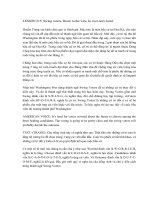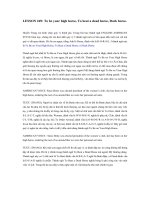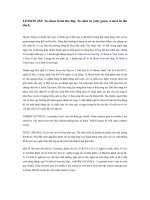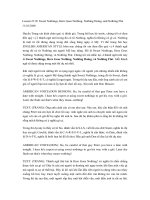Tài liệu communicate in workplace docx
Bạn đang xem bản rút gọn của tài liệu. Xem và tải ngay bản đầy đủ của tài liệu tại đây (17.17 KB, 8 trang )
Unit: WRRCS.1A - COMMUNICATE IN THE WORKPLACE page 1 of 3 Retail Curriculum Framework.
Content/HSC Requirements Assessment Evidence Requirements Skills/Activities Resources
CS1.1 Establish Contact with
customers.
• provide a welcoming customer
environment by treating
customers in a courteous and
helpful manner in accordance
with store procedures and
policies.
• provide an effective service
environment through effective
communication:-
∗ verbal communication
∗ non-verbal
communication.
∗ open-ended questions.’
∗ closed questions.,
∗ reflective questions.
∗ active listening
♦ Role play
♦ Peer
assessment.
Critical aspects of evidence.
Evidence of the following
knowledge and skills is considered
essential to demonstrate
competency in this unit.
• providing a consistently
welcoming environment by
treating customers.
• using effective questioning and
active listening techniques to
communicate with customers,
while maintaining an
awareness of the need for
discretion, tact and
confidentiality.
• interpreting and
communicating information
accurately to customers,
♦ Simulation of
self-
presentation.
♦ Role plays
♦ verbal/non-
verbal
communication.
♦ View snippets
of “Pretty
Woman”: video
♦ NRTM No. 2
and 3
Sections A &
B
♦ Video - Body
Language:
An
introduction
to non-verbal
communicati
on.
♦ Video Hire
“Pretty
∗ body language.
• comprehend and process
information gained from
customers to determine and
satisfy customer needs.
• consistently follow routine
instructions and seek
advice/assistance from a
supervisor if required.
CS1.2 Process Information.
• answer telephone promptly and
courteously in accordance with
store policies.
• use appropriate questioning and
active listening techniques to
identify caller and accurately
establish and confirm caller
requirements.
• message and/or information
♦ Demonstratio
n during
work
placement.
♦ Simulation
♦ - processing
information.
♦ - telephone
techniques.
♦ Workplacem
ent.
supervisors and peers both face
to face and via other
communication electronic
equipment.
• accessing, comprehending and
processing information
accurately according to store
policies and procedures.
• consistently following routine
instructions and seeking
advice/assistance if required.
• participating actively and
positively within a workplace
team.
• consistently applying store
policies and procedures, in
regard to personal hygiene and
code of conduct.
• consistently meeting store
and
”Faulty Towers”
“Fruit Salad:
Episode
*Analyse customer
service techniques
of both situations.:
♦ Simulation of
- answering
telephone
- recording
messages.
- passing on
Woman”.
♦ Store
signage.
♦ NRTM NO. 2
Section C.
recorded and passed on
promptly.
• follow - up action taken as
necessary.
scheduling routines and using
time effectively.
• interpreting, calculating and
recording numerical
information accurately.
messages.
Unit: WRRCS.1A: COMMUNICATE IN THE WORKPLACE. - page 2 of 3 Retail Curriculum
Framework.
Content/HSC Requirements Assessment Evidence
Requirements
Skills/Activities Resources
CS1.3 Work in a Team.
• participate actively and
positively within a workplace
team.
∗ assertiveness.
∗ listening
∗ speaking.
∗ conflict resolution.
∗ negotiation.
∗ allocation of tasks.
∗ seek assistance when
required.
∗ consistently apply store
policies.
∗ provide constructive
♦ Role play.
♦ Observation.
♦ Oral
questions.
♦ Decision making
techniques.
♦ Problem solving.
♦ Role play group
activity.
♦ Observation and
feedback.
♦ Organise rosters -
♦ NRTM No. 2
Section D
feedback to team
members.
∗ participate in team
problem solving.
CS1.4 Maintain Personal
Presentation.
• personal dress and presentation
maintained in a neat and tidy
manner.
• maintain personal hygiene
according to store policy and
government legislation.
CS1.5 Follow routine
instructions.
• receive and act upon
instructions.
• use effective question to elicit
♦ Dress and
presentation.
♦ Oral
questioning.
♦ Demonstratio
n.
♦ Simulation.
♦ Workplacem
ent
assessment
negotiation and
conflict resolution.
♦ Modelling of
appropriate dress
and presentation in
work environments.
♦ (students are to
dress assuming they
are working in
retail).
♦ NRTM pp56-60.
Learning activities.
- questioning
techniques.
- following instructions.
♦ “Pictionary”
♦ NRTM No 2 p.61









